Beverly Boy Detroit Video Production
Are you seeking video services in Detroit? You’ve come to the right place at Beverly Boy Detroit video production. We’ve been producing quality videos in Detroit for decades. Incorporating the best video technology and trends, we aim to deliver a unique and captivating experience for clients seeking effective video content in Detroit. We specialize in an array of video production services in Detroit including commercial, television, film and corporate video production. Take a look at some of the recent videos we’ve filmed in Detroit.
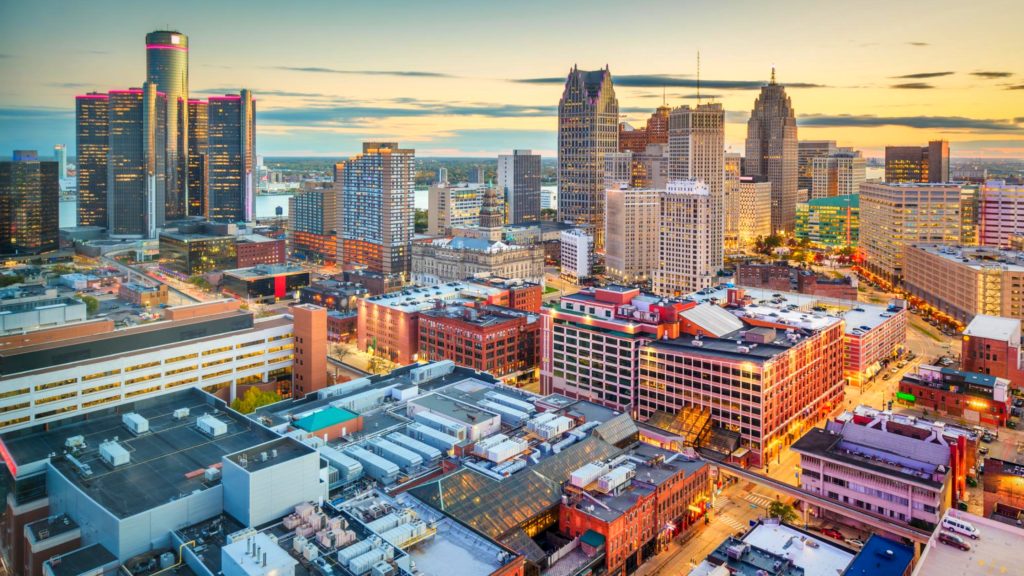
[blog-contact email=”email” label=”Get a Detroit video production quote here!”]
History of Detroit & Detroit Nicknames
Motor City is the most populous city in the state of Michigan and the largest Americanized city on the border of the US and Canada, but Detroit wasn’t always such a big and famous city.
The early years of Detroit date back to the Paleo-Indian people that are said to have inhabited the area hundreds of years ago. It wasn’t until the 1700s when Europeans began to penetrate the area pushing out the Iroquoian tribes that had been there since the 1600s.
The French Influence
The city was named by French Colonists that referenced the Detroit River then called “le detroit du lac Erie, meaning the strait of Lake Erie, back in 1701. More than a hundred settlers had come to the area and, by 1765, the city of Detroit would have a population of 800 people.
The population would grow rather fast for the large European settlement thanks to the convenience of the location being just between Montreal, Canada and, the French settlements in New Orleans.
By 1773, the population had nearly doubled to 1400 people and by the end of the century, Detroit had more than 2K residents making it the third largest city by population in the Province of Quebec.
Native Americans traded fur in the city as French-Canadian settlers continued to move into the area for several years. Detroit would continue to be dominated by the French-Canadians until the late 19th century when Anglo-Americans would begin to move into the suburbs.
The American Revolution
Britain ceded Detroit after the American Revolutionary War in 1796 and an established border between the northern US and Canada was defined.
Just a few years later, in 1805, the city was destroyed by fire leaving behind a single stone fort, a river warehouse and a few brick chimneys that had once been attached to wooden structures that were home to the then 600 settlers that had populated the area. Thankfully nobody died in the fires but the city was left in shambles.
Siege of Detroit
The capital of Michigan the territory and later the state, Detroit surrendered to the British in the Siege of Detroit of 1812. The city would not be reacquired by the United States until later in 1813 following several battles.
In 1815 Detroit was incorporated and a street plan with boulevards similar to Paris was developed by Augustus B Woodward. The city would soon become a stopping point for refugee slaves seeking freedom from slavery via the Underground Railroad.
An estimated 25K African-American refugees passed through the city on their way to Canada seeking solace from the rough times.
Late 19th Century
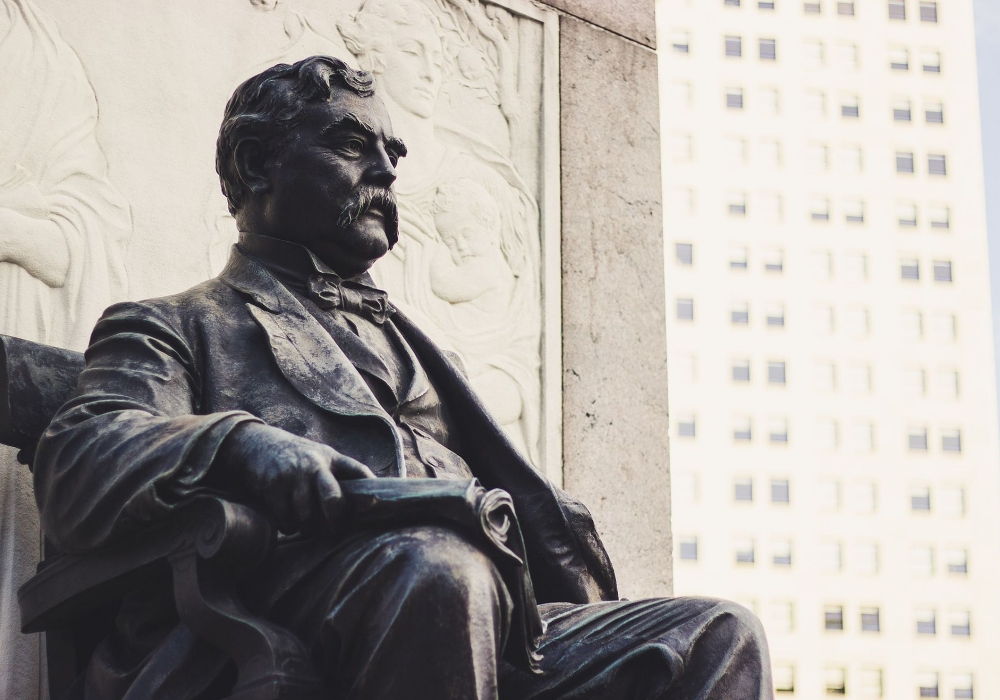
The city would see a boost in power and wealth in the late 19th century as the Woodward plan continued to unfold and areas east and west of today’s current downtown Detroit area were established by some of the wealthier residents complete with grand avenues and several mansions that would be electrified by Thomas Edison at the turn of the century.
The thriving carriage trade would later prompt Henry Ford to build his first automobile plant on Mack Avenue in 1896. Borders of Detroit would expand via annexation of the surrounding villages and townships to accommodate the growth that Detroit faced during this time.
It was this move, all those years ago, that gave way to Detroit being known as Motor City for the next several decades.
The Fort Motor Company
Ford Motor Company was founded by Henry Ford in 1903, in Detroit. Later several other automobile manufacturers would also call Detroit home including the Dodge Brothers, and Walter Chrysler.
Throughout the 20th century, Detroit would be the automobile capital of the world and growth of the auto industry would lead to rapid development of the Midwest and the nation to include the construction of several automobile shops, gas stations and factories that would produce parts, tires and accessories for the cars.
Unionization
Detroit’s rapid growth led to several labor unions and organized programs fighting to gain better working conditions for those working in the auto factories. Strikes and various other labor activism influences would take place leading to the establishment of the Teamsters as well as the American Federation of Labor and the United Auto Workers unions during this time.
By 1920, Detroit was the 4th largest city in the nation preceded by New York, Chicago, and Philadelphia. Alcohol prohibition would lead to smuggling of spirits up the River throughout the late 1920s and into the 1930s. The city would continue to grow throughout the 1940s when the first urban depressed freeway was built in Detroit, the Davison.
Population
In 1950, Detroit’s peak population would reach 1.849M people making it the city with the 5th largest population in the United States preceded then by New York City, Chicago, Philadelphia and Los Angeles.
Later surges in African-American population follow the Great Migration would place a strain on housing scarcity as residents were turned away from obtaining home loans and interest rates were unfairly inflated to prevent African-Americans from moving into predominantly white neighborhoods. Thus the racial divide would continue to impact postwar Detroit.
While in 1950 the city of Detroit held one third of the state of Michigan’s total population within the next 60 years, population would stagnate and decline rapidly for the city. In the end, the city would have less than 10 percent of the state’s population.
The Late 1900s
Riots would jeopardize the city and thousands of businesses would close permanent as a result of the riots that left Detroit in ruins. Continued racial segregation in public schools and unfair housing practices would lead to to further troubles for Detroit.
A final Milliken v. Bradley decision made by the Supreme Court would cause more riots in the city and many of the existing white families that were left at that time would leave thus further impacting the tax burdens of the city and leaving Detroit struggling.
The 1970s would bring Detroit the first black mayor and emphasis would be placed on increasing racial diversity within the town and in the police department. A $600 million approval from the federal government in 1976 would lead to plans for a rapid transit system to be built in the city.
Unfortunately, Detroit and neighboring cities were unable to overcome conflicts in the planning process and the region would lose much of the funding as a result. A much smaller transit system, that was elevated above downtown called the Detroit People Mover would instead be built.
Fuel Crisis
Gas crisis throughout the 1970s would result in more struggles for Detroit as the local auto industry would decline as a result of residents seeking more affordable, and fuel-efficient vehicles that were largely produced overseas.
Detroit would continue to decline despite attempts to improve the city with retail and various other business such as at a Renaissance Center retail complex and various other projects. More hotels and stores would close throughout the city further reducing population and tax income for Detroit.
1980s
The 1980s would be mostly uneventful for the city of Detroit with the exception of the Northwest Airlines Flight 255 crash which took place just outside the city killing 154 of the 155 people on board as well as two people that were impacted on ground level.
The 1990s were likewise uneventful for the city overall. Casino gambling was made legal in the city in 1996 and temporary hotels and casinos popped up in 1999. Permanent casinos would not come to the city for nearly another decade.
Modern Day
Throughout the early 2000s focus has been very much on improving the riverfront and redeveloping the International Riverfront, an area of several miles of parks and landscaping along the water.
Continued renovation of downtown historic buildings played into 2006 and up to 2015 even. By 2014, the number of vacant buildings in downtown Detroit went from 50 percent to approximately 13 percent. Initiatives continue to improve Motor City’s riverfront and inner city areas as well as the suburban towns that make up this vibrant city.
Along the way, Detroit has gained several popular nicknames relative to the history of the city. While Motor City is the most widely used nickname for Detroit, others include Detroit Rock City, Motown D. Tiger Town, The Automotive Capital of the World, the Renaissance City and Startup City, USA.
Even nicknames such as The City of Reinvention focus on the history of the city and the overarching goal of reinventing and re-beautifying the city. It’s no wonder so many filmmakers flock to Detroit to experience the timelessness and culture of America’s Motor City town alongside the crews that make up Beverly Boy Detroit video production.
Famous Movies Filmed in Detroit
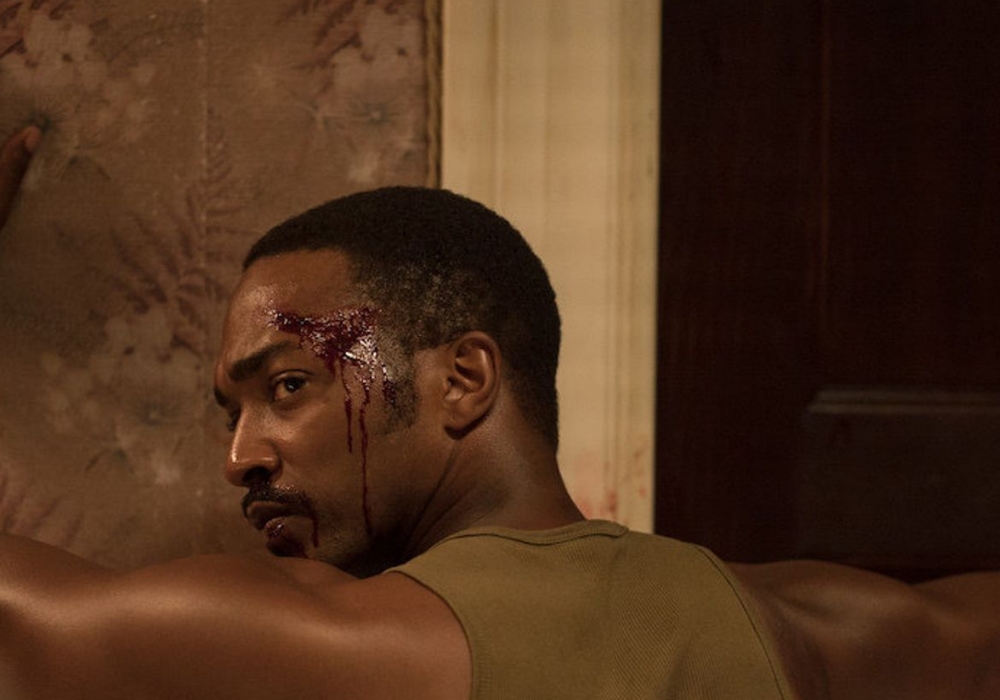
Several films and famous movies have been captured on location in Detroit, Michigan. Thanks to the Michigan Film and Digital Media Incentive which was signed into law in 2008 by Governor Jennifer Granholm, several films were filmed in the city over the next several years before the the incentive was scrapped.
Since the film incentive was cut in 2015, noticeably fewer films have been produced in the area due to the high cost associated with production in Detroit versus nearby Canada towns.
The following movies are both filmed in Detroit and feature Motor City within them as part of the setting:
- 8 Mile – Filmed at the Michigan Theatre Building, this film is one of the most iconic films to be shot in Detroit and features Eminem.
- The Island – also filmed at the Michigan Theatre Building, the Island stars Ewan Mcgreggor.
- Transformers: The Last Knight – Filmed at the Packard Plant, this film featured several different detroit locations.
- Batman vs. Superman: Dawn of Justice – This film was shot at the Detroit Public Library which dates back to early Detroit and was built in 1921.
- It Follows – filmed at the Redford Theater, a historic movie house that was built in 1928.
- The Myth of the American Sleepover – filmed at the Russell Industrial Center, this indie film is set inside the manufacturing plant that is over 100 years old.
- Whip It – also filmed at the Russell Industrial Center, this film was directed by Drew Barrymore.
- Scream 4 – although the majority of this film was not caught in Detroit there are scenes that feature Devin Scillian, Detroit’s NBC News Anchor.
- Up in the Air – released in 2009 and filmed partially at the Detroit Airport, this movie stars George Clooney.
Production agencies Paramount Pictures, Swan Productions, Take one Productions, Universal and Renaissance Pictures have all been known to film in Detroit. Dating back as far as 1946 when This Time for Keeps was filmed in Detroit and produced by MGM studios, to recent years.
Years when various entertainment groups including Paramount Pictures and Vertical Entertainment featured releases of Transformers and Eloise from Detroit, filmmaking has long been respected in the town and represents continued opportunity for economic improvement of the city of Detroit.
Detroit Film Office, Film Organizations & Local Film Groups
The Detroit Film Office is responsible for much of the film industry in the city of Detroit. Filmmakers interested in film permits or who have questions relative to producing films in Detroit should visit their website.
Located in the Coleman A. Young Municipal Center on Woodward Avenue, the Detroit Film Office handles small features and silver screen productions providing no–fee general permits and B-roll Permits to film companies seeking to enter the city for the purpose of film production.
For resources and further support in the film industry, several Detroit film organizations and local film groups are found throughout the city.
Resources include:
- Michigan Film Office – providing creative support to digital media artists, filmmakers and producers throughout the state of Michigan.
- Oakland County Film – supporting Oakland County film crews and talent with affordable office space, studio rentals, and production support.
- Film Macomb – located in Detroit and providing location information as well as various other support services for production in Detroit.
Detroit TV/Film Unions and Guilds
Several film unions and guilds can be found Detroit providing support through collective bargaining that assists cast and crew with labor-related guidance. For details on local Detroit unions, consider each of the following websites for your review.
Remember, your decision to join a labor union is always your choice and should be undergone only after you have done due diligence and researched your options thoroughly.
The following Detroit film unions and guilds can be found offering you assistance throughout your production career in the area:
- Detroit Branch of American Federation of Television and Radio Artists – SAG-AFTRA of Michigan supports recording, commercial and motion picture artists throughout Michigan.
- Detroit Branch of the Screen Actors Guild – Providing support to screen actors of Michigan throughout Detroit and surrounding cities.
- The Detroit -Pontiac Stage Employees Union – IATSE Local 38 – providing support to Detroit stagehands and those in the entertainment industry including lighting operators, sound mixers and video camera operators in Detroit.
- Society of Motion Picture and Television Engineers, Detroit Section – supporting motion picture engineers and broadcast television artists in Detroit, Michigan and surrounding areas.
- Teamsters Local 337 – One of the earliest unions in Detroit, providing support to 6600 members throughout Detroit through bargaining rights and labor agreements.
Detroit Weather & Geography

Detroit is located in close proximity to Canada and surrounding by a nine-county statistical area that makes up a total population of 5.3 million people within 5,814 square miles. The 142 square miles that make up Detroit is primarily land with just 4.12 square miles consisting of water.
The primary city in Metro Detroit and situated along the Midwestern US in the Great Lakes Region, Detroit attracts filmmakers seeking access to Monroe Avenue and the many historical commercial buildings that makeup downtown Detroit.
Physical Geography
Since the city is primarily made up of flatlands with a peak elevation found just north of Gorham Playground slightly northwest of 8 Mile Road, Detroit is topically balanced overall. The most notable change in topography within the city is the Detroit Moraine, a clay ridge that rises as much as 62 feet above the river at the highest point.
The majority of filmmakers that come to Detroit don’t really come for the geography so much as they do for the scenic buildings such as old warehouses, theaters, shopping plazas and of course automobile plants.
However, weather in Detroit can attract filmmakers, especially during the summer months when temperatures are mild and comfortable much of the time.
Local Climate
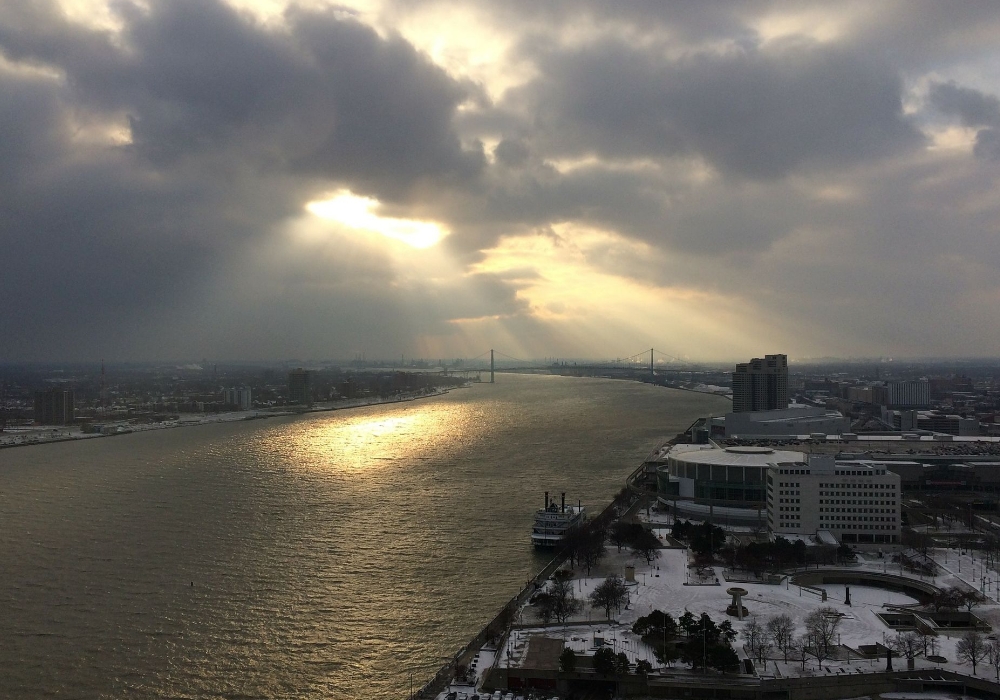
Summers in Detroit are warm and the winters are exceptionally cold and windy with plenty of snow. Therefore, when it comes to visiting the city for film production, summer is certainly the most welcoming time and easiest to travel during. June through mid-September represent the best time to visit Detroit for film production.
Temperatures range from average lows in the 20s in late January up to average highs in the mid 80s in late July. Cloud cover varies significantly by season in Detroit. The cloudiest part of the year tends to begin in November and runs for the next 7 months until June.
January represents the cloudiest time of the year when skies are cloudy 63% of the time. If filming outdoors, clouds can be used to your advantage during these months more so than in other parts of the year when fewer clouds cover the city.
Precipiation
Rain chances in Detroit also vary much like the cloud cover and temperatures of the city. The greatest chance for rain is generally from March to October when average daily precipitation chances are around 26% most days. On dryer days, rain chances can be significantly lower, especially from October until March.
Snowfall has a significant impact on tourism and filmmaking in Detroit. Snow alone is a common element for Detroit, especially from January to February. Cold, dry snow lasts for about 4.5 months out of the year with the majority of the snowfall coming from November until April.
The amount of snowfall ranges during these times depending on various elements. If you’re seeking to produce a film that incorporates snow into the scene, visit Detroit from November to march with peak time late January to experience snow.
Detroit Economy, Demographics & Detroit Transportation
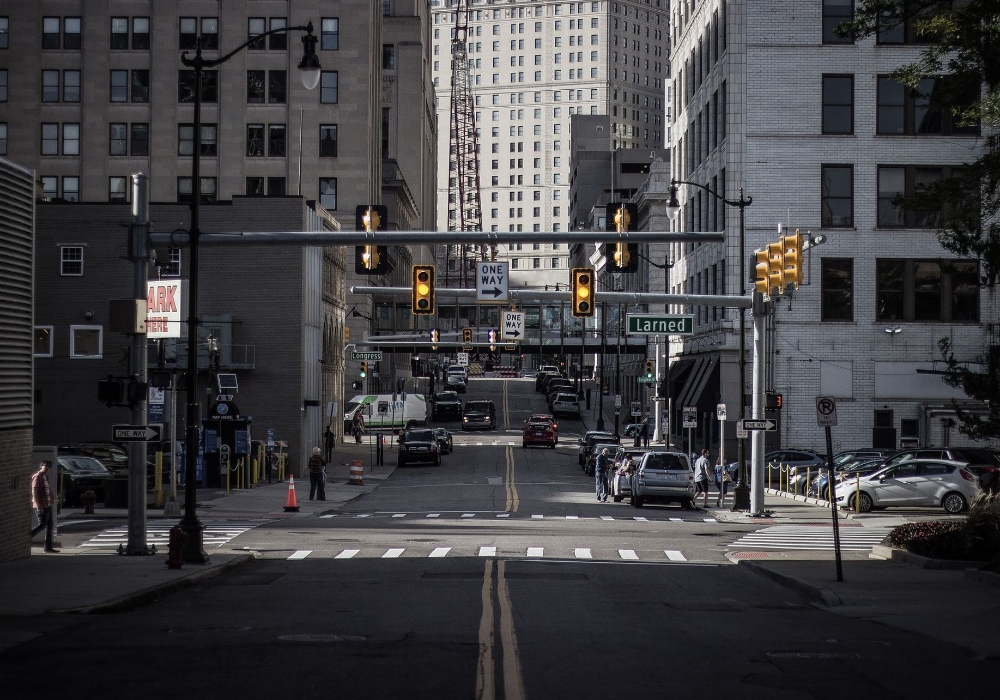
The economy in Detroit has struggled throughout the history of the city. Recent reviews show that Detroit continues to shrink from it’s highest population which took place in the 1950s when Detroit had nearly 2M people residing in the area. Approximately 162K families make up more than half of the 269K households that live in Detroit now.
Housing density has declined over the years in Motor City where the median age is 31 years old and the population is predominantly male.
Local Income
Income for working-class Detroit struggles much like the rest of the city. Poverty is one of the city’s greatest problems where the estimated median household income as of 2009 was just $26K., significantly lower than the U.S. National Average.
Per capita income in the city is just $14K with nearly one third of all families in the city living below federally defined poverty levels.
Where Oakland County in Metro Detroit was once considered one of the richest areas in the country in early development of the city, today the count is no longer in the top 25 listings for wealthiest counties in the country.
Travel
The Detroit Department of Transportation is responsible for helping visitors and residents get to where they are going while in the city. Several transportation options exist in Motor City where an average of 84K daily riders use public transit throughout the city as well as surrounding cities, suburbs and areas such as Highland Park and Hamtramck.
The 26 Junction provides a neighborhood route that takes visitors and residents through McGraw Junction, the Michigan Department of Health and Human Services (MDHHS), Southwest Service Center, Clark Park, and the Southwest Public Safety Center.
Public Transportation
Local bus services throughout the city provide up to 100K rides per day to passengers. SMART busses also provide transportation to residents and visitors including filmmakers throughout the city. The SMART bus offers door-to-door transit for seniors of Detroit as well as those with certain disabilities.
The QLine Streetcar also provides modern transportation services in the city. From Woodward Avenue through Downtown Detroit and into midtown, the Rail can be used via three-hour passes that provide unlimited rides for just $1.50 as well as full-day passes for just $3.
Finally, the Detroit People Mover, built many years ago and deeply a part of Detroit’s history, continues to provide transportation along a 2.9 mile, elevated rail loop that runs throughout downtown Detroit.
The People Mover is a popular transportation element for Detroit tourists, those visiting the convention center and Detroit sports fans.
Additional Detroit transportation services include:
- AAATA the Ride – a bus system running in Ann Arbor
- AirRide – another Ann Arbor to DTW bus service
- Detroit Connector – a Bus service running in Ann Arbor and Dearborn
- Transit Windsor – the Windsor bus system
- Amtrak – the Detroit and national traveling train system
- MegaBus – the Detroit and national traveling bus system
- MoGo – bike rentals within the city
- E-Scooter – powered motor-scooter rentals throughout the city
- Ride-Hailing – taxi, Lyft and Uber services to take riders through the city and beyond.
If you have questions about Detroit transportation services, contact the Detroit Department of Transportation or the Southeast Michigan Regional Transit Authority.
Detroit Recreational Activities

Recreational activities in Detroit include several museums, bars, restaurants and attractions. Most notably are the various automobile manufacturers in the city that make up a major part of the history of Detroit and which attract visitors from around the world.
While in Detroit, take a walking tour and ride the People Mover for cultural insight into Motor City. Stop at a couple of bars downtown to enjoy a drink and maybe a bite to eat.
Walk Through History
Historically, the Detroit Masonic Temple offers an impressive glimpse into Gothic architecture. The Temple was built out of Limestone from Indiana and features three areas that you can explore.
The Detroit Public Library is a popular attraction for tourists, especially those entering the city for a film production as the Library has been featured several times in films throughout Detroit’s history.
Historic Fort Wayne provides a glimpse into the 1840s architecture of Detroit. And a visit to the Henry Ford Museum will take you through the years as technology and the automobile industry would change Detroit forever.
Nightlife
If having a few drinks after a long day of filming is your idea of a relaxed and welcoming time, checkout Detroit’s bar scene which features literally something for everyone. From old-school Jazz clubs to distinctive wine bars, Detroit is sure to please your palate.
Visit Abick’s Bar, a Detroit landmark that has been in the city for more than 100 years. If the production of distilled spirits amazes you, visit Two James Distillery to test out the latest whiskey, bourbon and cocktail mixes that will amaze you.
Sporting
From tours of the Guardian Building to kayaking the Detroit River to sports games by the Detroit Lions, Pistons, Red Wings or Tigers, you’re sure to find plenty to see and do while your in Detroit filming.
As you plan your trip, just make sure you have plenty of time to get around the town and enjoy all the Motor City has to offer. Beverly Boy Detroit video production crews certainly aren’t lying when they say that Detroit is a vibrant city with a rich culture and a welcoming environment that cannot be overlooked!

